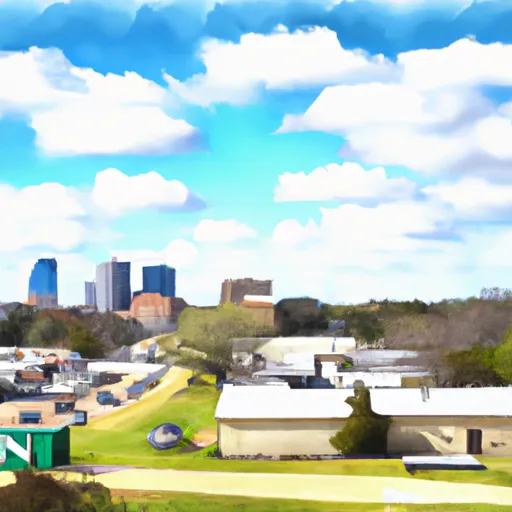-
 Snoflo Premium
Snoflo Premium
Get unlimited access to all our content
With no Ad interruptions! - Start Your Free Trial Login with existing account
Jacksonville
Eden Index
Climate
9.7
•
Recreation
4.1
•
Community
2.0
•
Safeguard
5.8/10

Jacksonville, Texas is a charming city located in the northeastern part of the state. It has a humid subtropical climate, characterized by hot, humid summers and mild winters. Summers bring high temperatures averaging around 95°F (35°C), while winters see temperatures in the mid-50s°F (10-12°C). Rainfall is evenly distributed throughout the year, with around 50 inches (127 cm) annually.
Hydrologically, Jacksonville is situated near multiple water bodies, including Lake Jacksonville and the Neches River. These water sources offer opportunities for fishing, boating, and various water sports. Lake Jacksonville covers an area of 1,320 acres and is renowned for its bass fishing. The Neches River, which runs nearby, is ideal for kayaking and canoeing, providing a peaceful escape amidst scenic riverbanks.
Apart from its hydrological attractions, Jacksonville offers a range of outdoor recreational opportunities. Love's Lookout is a popular spot for hiking and sightseeing, offering breathtaking views of the surrounding countryside. The Nichols Green Park provides picnic areas, walking trails, and a disc golf course. Additionally, Jacksonville boasts several parks and nature preserves, including Tomato Bowl Park and the Cherokee Trace Drive-Thru Safari, where visitors can explore the local flora and fauna.
Overall, Jacksonville, Texas provides a pleasant climate, abundant water resources, and numerous outdoor activities, making it an attractive destination for nature enthusiasts and adventure seekers.
What is the Eden Index?
The Snoflo Eden Index serves as a comprehensive rating system for regions, evaluating their desirability through a holistic assessment of climate health, outdoor recreation opportunities, and natural disaster risk, acknowledging the profound impact of these factors on livability and well-being.
Climate Health Indicator (CHI): 9.7
Jacksonville receives approximately
1151mm of rain per year,
with humidity levels near 79%
and air temperatures averaging around
19°C.
Jacksonville has a plant hardyness factor of
8, meaning
plants and agriculture in this region tend to thrive here all year round.
By considering the ideal temperature range, reliable water supplies, clean air, and stable seasonal rain or snowpacks, the Climate Health Indicator (CHI) underscores the significance of a healthy climate as the foundation for quality living.
A healthy climate is paramount for ensuring a high quality of life and livability in a region, fostering both physical well-being and environmental harmony. This can be characterized by ideal temperatures, reliable access to water supplies, clean air, and consistent seasonal rain or snowpacks.
Weather Forecast
Streamflow Conditions
Neches
Area Rivers
Neches
Snowpack Depths
Neches
Reservoir Storage Capacity
Neches
Groundwater Levels
Recreational Opportunity Index (ROI): 4.1
The Recreational Opportunity Index (ROI) recognizes the value of outdoor recreational options, such as parks, hiking trails, camping sites, and fishing spots, while acknowledging that climate plays a pivotal role in ensuring the comfort and consistency of these experiences.
Access to outdoor recreational opportunities, encompassing activities such as parks, hiking, camping, and fishing, is crucial for overall well-being, and the climate plays a pivotal role in enabling and enhancing these experiences, ensuring that individuals can engage in nature-based activities comfortably and consistently.
Camping Areas
| Campground | Campsites | Reservations | Toilets | Showers | Elevation |
|---|---|---|---|---|---|
| Tyler State Park | 104 | 637 ft | |||
| Rusk - Palestine Park | 71 | 447 ft | |||
| Fish Hawke Point | None | 359 ft | |||
| Double Lake | 74 | 301 ft | |||
| Lake Hawkins County RV Park | 50 | 366 ft | |||
| Mission Tejas State Park | 15 | 440 ft | |||
| Ratcliff Lake | 72 | 383 ft | |||
| Wolf Creek Park - Lake Livingston | 100 | 195 ft | |||
| Lake Jacksonville Campground | 17 | 427 ft | |||
| Lake Houston Wilderness Park | None | 102 ft |
Catastrophe Safeguard Index (CSI):
The Catastrophe Safeguard Index (CSI) recognizes that natural disaster risk, encompassing floods, fires, hurricanes, and tornadoes, can drastically affect safety and the overall appeal of an area.
The level of natural disaster risk in a region significantly affects safety and the overall livability, with climate change amplifying these risks by potentially increasing the frequency and intensity of events like floods, fires, hurricanes, and tornadoes, thereby posing substantial challenges to community resilience and well-being.
Community Resilience Indicator (CRI): 2.0
The Community Resilience Indicator (CRI) recognizes that education, healthcare, and socioeconomics are crucial to the well-being of a region. The CRI acknowledges the profound impact of these elements on residents' overall quality of life. By evaluating educational resources, healthcare accessibility, and economic inclusivity, the index captures the essential aspects that contribute to a thriving community, fostering resident satisfaction, equity, and social cohesion.

